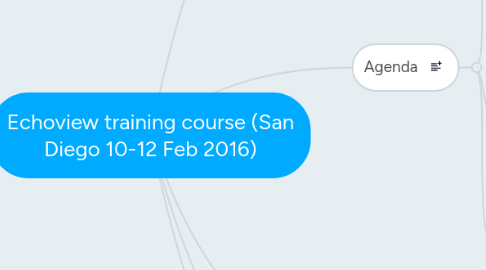
1. Learning modules
1.1. Echoview features
1.1.1. Overview
1.1.2. Guidelines
1.1.3. Topics
1.1.3.1. Echoview data model/hierarchy
1.1.3.1.1. Echoview
1.1.3.1.2. EV file(s)
1.1.3.1.3. Fileset(s)
1.1.3.1.4. Data file(s)
1.1.3.1.5. Raw variable(s)
1.1.3.1.6. Virtual variable(s)
1.1.3.2. Properties dialog boxes
1.1.3.2.1. Echoview Configuration
1.1.3.2.2. EV File Properties
1.1.3.2.3. etc.
1.1.3.3. Dataflow window
1.1.3.4. Modules
1.1.3.5. Operators
1.1.3.6. Data types
1.1.3.6.1. Sv
1.1.3.6.2. Linear
1.1.3.6.3. etc.
1.1.3.7. Grids (cells)
1.1.3.8. Lines & line types
1.1.3.8.1. Raw
1.1.3.8.2. Editable
1.1.3.8.3. Virtual
1.1.3.9. Regions
1.1.3.9.1. Types
1.1.3.9.2. Classes
1.1.3.10. Special values
1.1.3.10.1. -999
1.1.3.10.2. 'No data'
1.1.3.10.3. etc.
1.1.3.11. Transducer geometry
1.1.3.12. Calibration settings
1.1.3.12.1. Auto-calibration
1.1.3.12.2. ECS files
1.1.3.13. Analysis
1.1.3.13.1. Analysis domains
1.1.3.13.2. On-screen analysis
1.1.3.13.3. Export analysis
1.2. Hydroacoustic theory
1.2.1. Overview
1.2.2. Guidelines
1.2.3. Topics
1.2.3.1. Sound in water
1.2.3.1.1. Vibration/oscillation and waves
1.2.3.1.2. Pressure (in Pa), power (in W) and intensity (in W m-2)
1.2.3.1.3. Scattering
1.2.3.2. Transducers
1.2.3.2.1. The piezoelectric effect
1.2.3.2.2. Piezoelectric materials (ceramic, composite)
1.2.3.2.3. Tonpilz elements (singing mushrooms)
1.2.3.2.4. Beam pattern
1.2.3.2.5. Equivalent beam width (ideal beam)
1.2.3.3. The sonar equation
1.2.3.3.1. The transmitted pulse (source level)
1.2.3.3.2. Transmission loss
1.2.3.3.3. Backscatter
1.2.3.4. Time-varied gain (TVG)
1.2.3.5. Scattering quantities
1.2.3.5.1. Volume backscattering coefficient (sv) and volume backscattering strength (Sv or MVBS)
1.2.3.5.2. Backscattering cross-section (sigma bs) and target strength (TS)
1.2.3.5.3. Area backscattering coefficient (sa) and nautical area scattering coefficient (sA or NASC)
1.2.3.6. TVG revisited
1.2.3.6.1. Point scattering (40logR)
1.2.3.6.2. Volume scattering (20logR)
1.3. Workflow
1.3.1. Overview
1.3.2. Guidelines
1.3.3. Topics
1.3.3.1. Explore
1.3.3.1.1. Data support
1.3.3.1.2. Fileset(s)
1.3.3.1.3. Dataflows & operators
1.3.3.1.4. Windows & menus
1.3.3.1.5. Navigation & selection tools
1.3.3.1.6. Data views
1.3.3.1.7. On-screen analyses
1.3.3.1.8. Logging, live viewing & live export
1.3.3.1.9. GoTo, skip-to-feature & integrams
1.3.3.2. Calibrate
1.3.3.2.1. GPS
1.3.3.2.2. Transducer geometry
1.3.3.2.3. Power to Sv and TS
1.3.3.2.4. Auto-calibration
1.3.3.2.5. Echoview Calibration Supplement (ECS) files
1.3.3.3. Clean
1.3.3.3.1. Data manipulation & filtering
1.3.3.3.2. Background noise
1.3.3.3.3. Intermittent noise
1.3.3.3.4. Attenuated signal
1.3.3.3.5. Background signal (imaging sonar)
1.3.3.4. Detect
1.3.3.4.1. Bottom detection & editing
1.3.3.4.2. Cells (grids, intervals & EDSUs)
1.3.3.4.3. Single-target detection
1.3.3.4.4. Single-target tracking
1.3.3.4.5. Aggregation detection
1.3.3.4.6. Aggregation tracking
1.3.3.4.7. Submerged aquatic vegetation
1.3.3.5. Classify
1.3.3.5.1. Objects in the water column
1.3.3.5.2. Bottom types
1.3.3.6. Characterise
1.3.3.6.1. Biomass density
1.3.3.6.2. Aggregation characteristics (echo-trace classification)
1.3.3.6.3. The deadzone
1.3.3.6.4. Sounder characteristics (calibration parameters)
1.3.3.7. Automate
1.3.3.7.1. Echoview templates (EV files)
1.3.3.7.2. Scripting via COM objects
2. Exercises
2.1. 1. Explore
2.2. 2. Calibrate
2.3. 3. Clean
2.4. 4. Detect
2.5. 5. Classify
2.6. 6. Characterise
3. Useful resources
3.1. Echoview keyboard shortcuts
3.2. Echoview modules
3.2.1. Echoview 6.1 and older
3.2.2. Echoview 7
3.3. Echoview operators and licencing
3.4. Supported sounders
3.5. Echoview technical support
3.6. Definitions and symbols in fisheries acoustics
4. Participants
4.1. Trainer
4.1.1. Toby Jarvis
4.2. Attendees
4.2.1. Danial Palance
4.2.2. Suzanne Manugian
4.2.3. Whitney Friedman
4.2.4. Ilysa Iglesias
4.2.5. Simone Baumann-Pickering
4.2.6. Ashlyn Giddings
4.2.7. Eadoh Reshef
4.2.8. Jennifer Trickey
4.2.9. Anne Simonis
5. Agenda
5.1. Wed 10th Feb 2016
5.1.1. 09:00-10:30
5.1.1.1. Setup
5.1.1.2. Introductions
5.1.1.3. Overview
5.1.2. 11:00-12:30
5.1.2.1. Echoview features
5.1.3. 13:30-15:00
5.1.3.1. Hydroacoustic theory
5.1.4. 15:30-17:00
5.1.4.1. Explore
5.2. Thu 11th Feb 2016
5.2.1. 09:00-10:30
5.2.1.1. Calibrate
5.2.2. 11:00-12:30
5.2.2.1. Clean
5.2.3. 13:30-15:00
5.2.3.1. Detect (pt1)
5.2.4. 15:30-17:00
5.2.4.1. Detect (pt2)
5.3. Fri 12th Feb 2016
5.3.1. 09:00-10:30
5.3.1.1. Classify (pt1)
5.3.2. 11:00-12:30
5.3.2.1. Classify (pt2)
5.3.3. 13:30-15:00
5.3.3.1. Characterise (pt1)
5.3.4. 15:30-17:00
5.3.4.1. Characterise (pt2)
